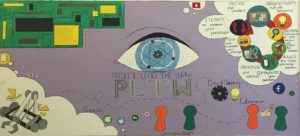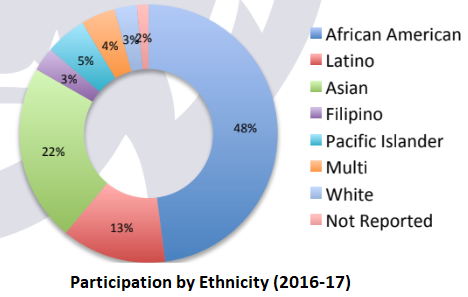 Students were hard at work on their laptops when we walked into the 12th grade environmental science class at Oakland High School. They were writing their senior research papers on different environmental issues in their Bay Area community, the culminating project to graduate from the Environmental Science Academy. One student was writing about the the economic impact of a diminishing bee population, another was looking into the effect of recent wildfires in northern California. And they were more than happy to show off their projects.
Students were hard at work on their laptops when we walked into the 12th grade environmental science class at Oakland High School. They were writing their senior research papers on different environmental issues in their Bay Area community, the culminating project to graduate from the Environmental Science Academy. One student was writing about the the economic impact of a diminishing bee population, another was looking into the effect of recent wildfires in northern California. And they were more than happy to show off their projects.
Oakland High School – or O-High as it is affectionately called by students and teachers – is one of several schools in California that is implementing an industry-based educational model called Linked Learning. Linked Learning is not unique – it outlines a framework for what we would consider “high-quality Career Technical Education (CTE):” an integrated pathway that combines rigorous CTE, college preparatory course work, work-based learning and wraparound student supports. But Linked Learning is quickly becoming the gold standard approach to career pathways in California. With funding from the James Irvine Foundation and strategic guidance and partnership from the Linked Learning Alliance, the approach has spread to high schools and districts across the state.
In Oakland, the power and value of Linked Learning is in the diversity of its student body. The city is situated across the bay from San Francisco and is home to an incredibly diverse community – many students are the children of immigrants or were themselves born in other countries. Recently, Oakland has experienced rapid gentrification and a steadily increasing cost of living, making it harder for families to stay in the area. To maintain Oakland’s rich diversity, O-High Principal Matin Abdel-Qawi believes it is his school’s mission to equip each and every student with the skills they need to earn family-sustaining wages so they can afford to work and live in Oakland once they graduate.
So what does this look like in practice? O-High has drawn upon the four components of the Linked Learning model to provide a student-centered experience. The school offers wall-to-wall career academies that each include:
Integrated academics with a rigorous, college-preparatory curriculum: As students progress through their pathway, they receive rigorous instruction aligned to California’s A-G college prep standards and graduate fully prepare to enroll in Easy Bay Community College, UC Berkeley, or other colleges and universities in the state.
High-quality CTE classes that prepare learners for in-demand careers: Every student enrolls in a career academy: Environmental Science, Visual Arts (VAAMP), Public Health, Project Lead the Way (engineering), Social Justice and Reform, or an academy for recent immigrants called R.I.S.E (Recent Immigrant Support and Engagement Academy). Students take math, history and other academic subjects with their pathway peers, and instructors adapt the curriculum to apply a career-focused lens.
A continuum of work-based learning experiences: Throughout their pathway, students have the opportunity to engage with industry experts through field trips, guest lectures and offsite internships with nearby institutions like the Alameda County health system, which regularly hosts students from the Public Health Academy. In 2018, 1,393 students participated in career awareness activities and 145 completed an internship.
Wraparound supports to guide learners along their pathway: Perhaps the most remarkable element of O-High’s Linked Learning academies is the extensive mentorship and wraparound supports students can access. A wellness center on campus provide medical and dental services to students, ensuring that health is not a barrier to success. The high school is also home to a Future Center that helps students apply for college, perfect their resume, and identify and apply for scholarships.
 The Linked Learning approach has had a notable impact on O-High student outcomes. In 2018, 81 percent of students graduated and 70 percent enrolled in college within one year. Part of this success is attributable to the high school’s absolute focus on equity. School leaders take special care to ensure that enrollment in each pathway reflects the broader student population, with parity across ethnicity, gender and disability. And in 2010, Oakland Unified launched the Office of African American Male Achievement (AAMA) to support and develop young black males throughout the district. As a result, the African American graduation rate at O-High jumped from 58 percent in 2014 to 90 percent in 2018.
The Linked Learning approach has had a notable impact on O-High student outcomes. In 2018, 81 percent of students graduated and 70 percent enrolled in college within one year. Part of this success is attributable to the high school’s absolute focus on equity. School leaders take special care to ensure that enrollment in each pathway reflects the broader student population, with parity across ethnicity, gender and disability. And in 2010, Oakland Unified launched the Office of African American Male Achievement (AAMA) to support and develop young black males throughout the district. As a result, the African American graduation rate at O-High jumped from 58 percent in 2014 to 90 percent in 2018.
As states prepare to implement the Strengthening Career and Technical Education for the 21st Century Act (Perkins V), they will have a unique opportunity to redefine what high-quality CTE looks like and ensure equity is front and center in the statewide delivery of CTE. There are a lot of lessons to draw from Linked Learning. For one, Linked Learning’s integrated career pathway approach, mixed with work-based learning and wraparound student supports, is a tried-and-true framework for a strong CTE program. States can replicate this approach and free up resources to expand access to work-based learning and student supports.
Further, O-High’s intense focus on equity should be instructive to other school, district and state leaders. In Oakland, equity means more than expanding opportunity. It means ensuring that each and every learner is supported, welcomed and successful in their given career pathway. With wraparound services to support students’ health, academic and career needs, Oakland High School delivers on its promise to graduate students prepared to stay and contribute to their diverse community.
Thanks to Oakland High School, the Linked Learning Alliance and the Alliance for Excellent Education for organizing the Linked Learning site visit.
Austin Estes, Senior Policy Associate
Tags: California, Equity, linked learning, work-based learning

